By Eric Vandenbroeck and co-workers
Cryptocurrency-Based Crimes
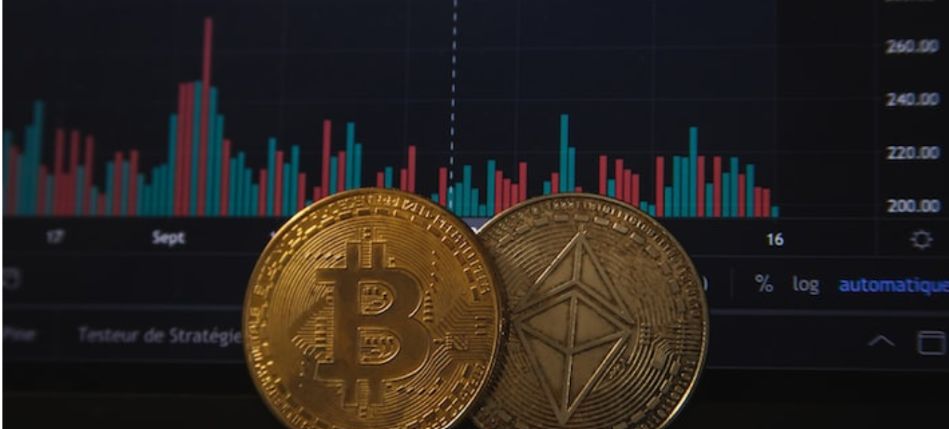
Once the poster child
for responsibility in the cryptocurrency sector, Sam Bankman-Fried was
sentenced to 25 years in jail on Thursday (March 28, 2024) following his
conviction in November in what prosecutors called one of the biggest financial
fraud cases in history.
US prosecutors were
seeking a prison term of between 40 to 50 years, after a jury found him guilty
on seven fraud and conspiracy counts contributing to the downfall of his FTX
company, as seen below, once a leading crypto exchange.
Sam Bankman-Fried,
known in the crypto community as "S.B.F.," founded the collapsed FTX
exchange in 2019, after launching the crypto hedge fund Alameda Research in
2017. Before his involvement in the cryptocurrency sector, he worked as a
trader on Wall Street. At his peak, Bankman-Fried held a fortune of $26 billion
(€24 billion).
Most people (while
knowing there was a phenomenon called cryptocurrency of which anywhere
also aware it was used to make underhand payments. Then more recently,
cryptocurrency also became USD as an investment tool by people who
thought cryptocurrency would increasingly become a legitimate currency with
even cryptocurrency vending machines that showed up in grocery stores.
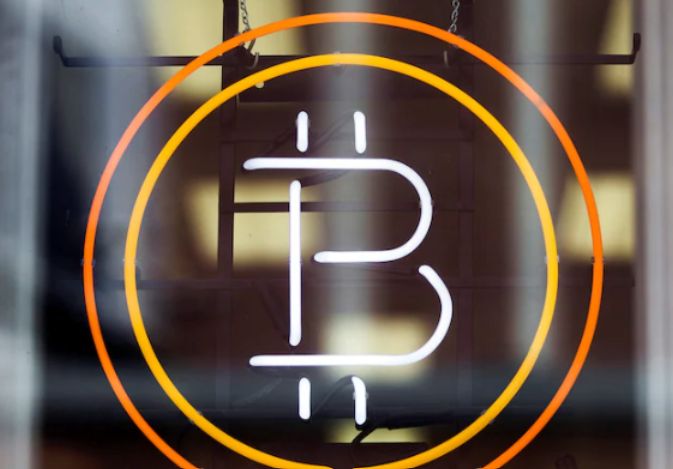
What brought our
attention to Sam Bankman-Fried’s case was when on 22 December 22,
Damien Williams, the US attorney for the Southern District of New York,
announced that Bankman-Fried's former colleague and onetime girlfriend,
Caroline Ellison, had pleaded guilty to seven criminal charges and was now
cooperating with the prosecutors.
Ellison's agreement
means she is waiving any defenses to charges against her. However, she'll very
likely serve nowhere near the maximum sentence of 110 years in prison for these
charges because of her cooperation.
As part of the deal,
Ellison must hand over documents, records, and evidence to prosecutors. She'll
be required to testify to a grand jury or at court trials when requested.
Ellison has also agreed to pay restitution at an amount to be determined by the
courts.
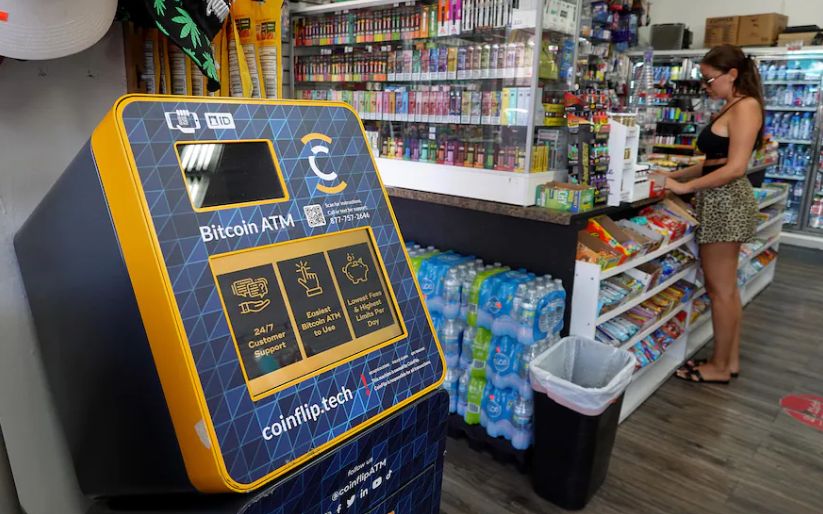
That is until the widely
aired arrest of Sam Bankman-Fried, who, as soon he set foot in the US was
allowed to go home and live with his parents..

But people didn't
seem to get the more significant part of the story.
Prosecutors Say FTX Was Engaged in a ‘Massive,
Yearslong Fraud’ A indictment unsealed on Tuesday and a complaint by the S.E.C.
describe years of wrongdoing in Sam Bankman-Fried’s crypto empire.
What To Know About The Case Against Sam Bankman-Fried
After the demise of his FIX crypto empire in November, Sam Bankman-
Fried portrayed himself as a hapless but well-intentioned chief executive who
made a series of calamitous mistakes, but never knowingly committed fraud. But
a day after his arrest in the Bahamas, the US Securities and Exchange
Commission, Department of Justice and Commodity Futures Trading Commission
filed civil and criminal charges against Bankman-Fried, including that he had
orchestrated a scheme to bilk equity investors out of more than $1.8 billion.
The next week, prosecutors announced that two members of his inner circle had
pleaded guilty to fraud charges.
1. What was FTX?
It had grown into a sprawling crypto enterprise, so much so that more
than 100 entities were included when FTX filed for bankruptcy. But at its heart
there were two organizations that mattered most: Alameda Research, the trading
venture that Bankman-Fried co-founded in 2017, and FTX Trading Ltd., a crypto
exchange based in the Bahamas and founded in 2019. All told, he raised more
than $1.8 billion from equity investors, the SEC said.
2. How did it grow so big?
Alameda initially made profits by applying traditional techniques of
arbitrage to the Bitcoin market. Bankman-Fried and co-founder Gary Wang found
ways to buy the world's biggest cryptocurrency on Asian exchanges where it was
selling for slightly less, and sell it on exchanges where it was selling for
slightly more, pocketing the difference. Bankman-Fried had previously been a
trader at Jane Street, a mainstream hedge fund. When he founded FTX, he
promoted it as a platform for financially sophisticated traders and touted its
automated risk management engine to the US Congress as superior to those used
by traditional market makers. At its peak in early 2022, FTX was valued at S32
billion by its equity investors.
3. How did it get into trouble?
According to the SEC, Bankman-Fried had “from the start” improperly
diverted assets that customers had deposited with FTX for use by Alameda to
fund its trading positions and venture investments, as well as personally make
“lavish real estate purchases and large political donations,” He and Wang
borrowed more than $546 million from Alameda to buy a nearly 8% stake in
Robinhood Markets Inc., according to court papers. As the broader crypto market
declined in value through 2022, other lenders began to seek repayment from
Alameda. Even though FTX had allegedly already given Alameda billions of
dollars in customer funds, Bankman-Fried began to give Alameda even more
4. What led to its collapse?
FTX issued its own token known as FTT. Alameda had begun using FTT,
along with tokens issued by entities that FTX either owned or invested in, as
collateral for its borrowing activities, while also using FTX customer funds to
trade with. But FTT isn't backed by substantial reserves of assets. That meant
its value was tied closelv to the fortunes of FTX
itself, making it worthless as collateral if FTX or Alameda ran into trouble
and urgently needed funds. Wien questions were raised about FTT by the chief
executive of rival exchange Binance, weak oversight
and risk management at FTX compounded the problem. As clients began to withdraw
funds from FTX, it didn't know where all its pots of money were or how much of
its assets it could liquidate in a hurry, and so struggled to honor requests. That
fed into customer panic, and accelerated their rush for the exit.
5. What did Bankman-Fried say?
Bankman-Fried argued that FTX's funding problems were limited to FTX International
Ltd., the larger entity that grouped its businesses outside of the US including
Alameda and about 100 other units. FTX US was still solvent, he said in
prepared remarks for US lawmakers prior to his Dec. 12 arrest. When the extent
of the collapse became clear, Bankman-Fried also blamed himself for what he
said was a series of accounting errors caused by poor risk management. He said
that Alameda's investments had been hit hard by the broader crypto meltdown,
and that when FTX called in loans it had extended to Alameda, the trading
outfit couldn't meet those requests. He added that he wasn’t aware that Alameda
was so heavily exposed to FTX.
6. Do regulators buy that?
No. According to SEC Chair Gary Gensler, Bankman-Fried built a
"house of cards on a foundation of deception while telling investors that
it was one of the safest buildings in crypto.” FTX’s own terms of service
stated that ownership of assets deposited on its platform remained with
customers, so it was not allowed to use them elsewhere in the group as
collateral to raise funds for other investments — particularly as FTX was not a
regulated bank. Additionally, as the majority owner of Alameda, Bankman-Fried may
have had more insight into the state of its affairs than he is letting on. The
SEC alleged that Bankman-Fried personally directed that FTX’s “risk engine” not
apply to Alameda — in effect giving what the SEC called an unlimited line of
credit funded by FTX customers — and hid the extent of the ties between the two
entities from investors.
7. What specific charges does Bankman-Fried face?
Bankman-Fried was charged in a Manhattan court with eight criminal
counts, including conspiracy and wire fraud. He’s also being sued by the SEC
and the CFTC for misleading investors. One of those eight criminal counts
includes violating campaign finance laws, alleging that the former billionaire
conspired with other unnamed individuals to use corporate money and shadow
donors starting in 2020 to contribute to political campaigns. FTX customers
were suing in a bankruptcy court to try to recover some of the billions lost in
the meltdown. After initially resisting extradition, Bankman-Fried was returned
to the US and was released on a $250 million bail package. Just before his
return, Manhattan US Attorney Damian Williams announced that two of
Bankman-Fried's closest associates, Wang and former Alameda Chief Executive
Officer Caroline Ellison, had pleaded guilty to fraud and were cooperating with
the prosecution.
8. What have they admitted to?
At a court hearing on Dec. 19, Ellison said she and Bankman-Fried
knowingly misled lenders about how much Alameda was borrowing from FTX. “I knew
that it was wrong,” she said, according to a transcript of the hearing. In his
own plea hearing, Wang, who had been FTX’s chief technology officer, said he
was "directed” to make changes to the FTX platform's code that he knew
would give Alameda special privileges, and that misrepresentations were being
made to customers and investors.
9. What has been the
reaction in the world of crypto?
Bankman-Fried’s
assertions have been met with little sympathy by his former peers, who are
worried that the string of bankruptcies triggered by the FTX collapse could
crush the crypto markets for years to come (if not permanently). Some have
pointed out that a weakness in the “bad luck” argument is that FTX doesn’t
appear to have performed any stress tests for a bank-run-style scenario. The
company sold itself as a benchmark of stability in a volatile industry, and
Bankman-Fried frequently and loudly said he was eager for FTX to be regulated.
But in the end, tokens it either owned or invested in — such as the FTT token
and another called Serum — crumbled to dust.
Overall, 2022 was a
brutal year for digital assets, as rising interest rates and high-profile
bankruptcies helped feed a broad and deep selloff in the market.
In 2022, the Federal
Reserve aggressively raised interest rates to tame soaring inflation, hiking
from near-zero in March to around 4.5% nine months later.
When interest rates
rise, savings accounts offer higher yields – meaning that holding cash becomes
more attractive than investing in assets like stocks, real estate, and
cryptocurrencies.
Digital asset prices
started tumbling in January as investors began to worry about the Fed
taking a stricter stance on inflation. That month alone, bitcoin slumped 19%, and Ethereum tumbled 29%.
So where people
like Sam Bankman-Fried simple innocent victims of the Federal
Reserve, aggressively raised interest rates?
A closer look
at Cryptocurrency-based crime tells us a different story.
Cryptocurrency-based
crime hit a new all-time high in 2021, with illicit addresses receiving $14
billion over the year, up from $7.8 billion in 2020. See here an example
of cryptocurrency value received by illicit addresses:
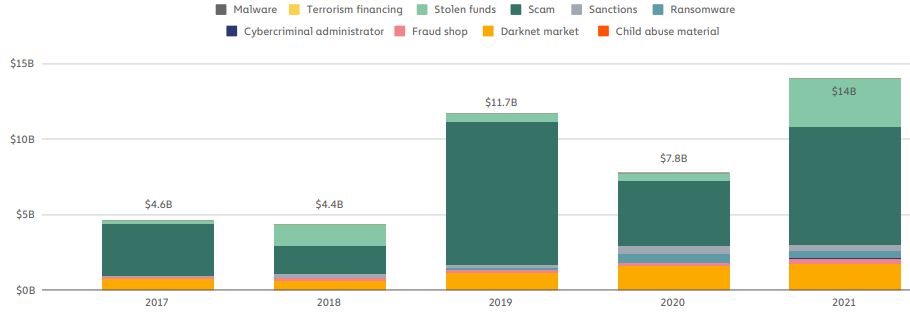
But those numbers
don’t tell the full story. Cryptocurrency usage is growing faster than ever
before. Across all cryptocurrencies tracked by Chainalysis,
total transaction volume grew to $15.8 trillion in 2021, up 567% from 2020’s
totals. Given that roaring adoption, it’s no surprise that more cybercriminals
are using cryptocurrency. But the fact that the increase in illicit transaction
volume was just 79% — nearly an order of magnitude lower than overall adoption
— might be the biggest surprise of all.
Illicit share of all cryptocurrency transaction
volume:
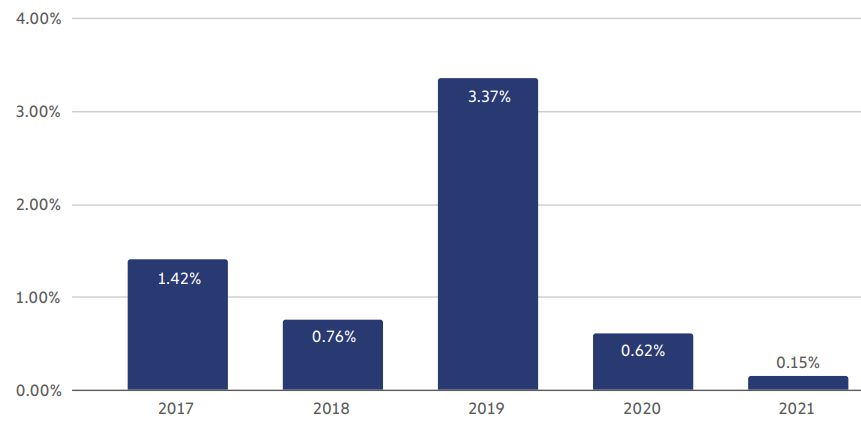
Transactions
involving illicit addresses represented just 0.15% of cryptocurrency
transaction volume in 2021 despite the raw value of criminal transaction volume
reaching its highest level ever. As always, we must caveat this figure and say
that it will likely rise as Chainalysis identifies
more addresses associated with illicit activity and incorporates their
transaction activity into our historical volumes. For instance, we found in our
last Crypto Crime Report that 0.34% of 2020’s cryptocurrency transaction volume
was associated with illicit activity — we’ve now raised that figure to 0.62%.
Still, the yearly trends suggest that except for 2019 — an extreme outlier year
for cryptocurrency-based crime primarily due to the PlusToken
Ponzi scheme — crime is becoming a smaller and smaller part of the
cryptocurrency ecosystem. Law enforcement’s ability to combat
cryptocurrency-based crime is also evolving. We’ve seen several examples of
this throughout 2021, from the CFTC filing charges against several investment
scams, the FBI’s takedown of the prolific REvil ransomware strain, and OFAC’s
sanctioning of Suex and Chatex,
two Russia-based cryptocurrency services heavily involved in money laundering.
However, we also have
to balance the positives of the growth of legal cryptocurrency usage with the
understanding that $14 billion worth of illicit activity represents a
significant problem. Criminal abuse of cryptocurrency impedes continued
adoption, heightens the likelihood of restrictions being imposed by
governments, and, worst of all, victimizes innocent people worldwide. In this
report, we’ll explain exactly how and where cryptocurrency-based crime
increased, dive into the latest trends amongst different types of
cybercriminals, and tell you how cryptocurrency businesses and law enforcement
agencies worldwide are responding. But first, let’s look at some key trends in
cryptocurrency-based crime.
The DeFi Scam
The crypto exchange’s
founder was throwing his weight behind regulation that would have helped his
bourse while undermining decentralized finance.
FTX’s
Sudden Unraveling May Allow Defi To Grow
A decentralized
finance (DeFi) system allows people to create financial products or “smart
contracts” that execute actions automatically on the blockchain – without any
bank, brokerage, exchange, or corporation acting as an intermediary. This
freedom has unleashed great experimentation in creating novel uses for DeFi –
such as auctioning off non-fungible (unique) tokens that have famously fetched
millions. But there are scores of other more day-to-day uses, as we’ll explore.
At the end of July
2021, the market capital for DeFi products was hovering near $80 billion. While
that was down from its May peak of more than $89 billion, pundits expect the
figure to rise in the coming year as DeFi projects mature, and as the cryptocurrency
industry makes progress on its highly public goal of lessening its
environmental impact.
Reality again paints a different picture.

Two categories stand
out for their growth: stolen funds and, to a lesser degree, scams. DeFi is a
big part of the story for both.
Let’s start with
scams. Scamming revenue rose 82% in 2021 to $7.8 billion worth of
cryptocurrency stolen from victims. Over $2.8 billion of this total — which is
nearly equal to the increase over 2020’s real — came from rug pulls, a
relatively new scam type in which developers build what appear to be legitimate
cryptocurrency projects — meaning they do more than set up wallets to receive
cryptocurrency for, say, fraudulent investing opportunities — before taking
investors’ money and disappearing. Please remember that these figures for rug
pull losses represent only the value of investors’ funds stolen and not losses
from the DeFi tokens’ subsequent loss of value following a rug pull.
We should note that
roughly 90% of the total value lost to rug pulls in 2021 can be attributed to
one fraudulent centralized exchange, Thodex, whose
CEO disappeared soon after the exchange halted users’ ability to withdraw
funds. However, every other rug pull tracked by Chainalysis
in 2021 involved DeFi projects. In nearly all of these cases, developers have
tricked investors into purchasing tokens associated with a DeFi project before
draining the tools provided by those investors, sending the token’s value to
zero in the process.
decentralized tokens
like Shiba Inu have many excited to speculate on DeFi tokens. At the same time,
it’s straightforward for those with the right technical skills to create new
DeFi tokens and get them listed on exchanges, even without a code audit. A code
audit is a process by which a third-party firm or listing exchange analyzes the
code of the smart contract behind a new token or other DeFi project. It
publicly confirms that the contract’s governance rules are ironclad and contain
no mechanisms to allow the developers to make off with investors’ funds. Many
investors could have avoided losing funds to rug pulls if they’d stuck to DeFi
projects that have undergone a code audit – or if DEXes
required code audits before listing tokens.
Cryptocurrency theft
grew even more, with roughly $3.2 billion worth of cryptocurrency stolen in
2021 — a 516% increase compared to 2020. Roughly $2.2 billion of those funds —
72% of the 2021 total — were stolen from DeFi protocols. The increase in DeFi-related
thefts represents the acceleration of a trend we identified in last year’s
Crypto Crime report.
Annual total cryptocurrency was stolen by victim type
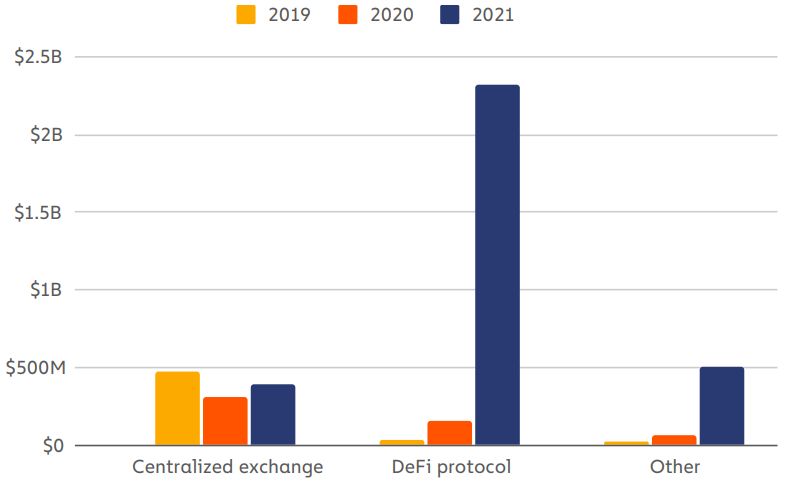
As we have seen in
the above-described Sam Bankman-Fried In case 2020, just under $162
million worth of cryptocurrency was stolen from Defi platforms, which was 31%
of the year’s total amount stolen. That alone represented a 335% increase over
the total stolen from Defi platforms in 2019. In 2021, that figure rose another
1,330%. In other words, as DeFi has continued to grow, so too has its issue
with stolen funds. As we’ll explore in more detail later in the report, most
instances of theft from DeFi protocols can be traced back to errors in the
smart contract code governing those protocols, which hackers exploit to steal
funds, similar to the errors that allow rug pulls to occur.
We’ve also seen
significant growth in the usage of DeFi protocols for laundering illicit funds,
a practice we saw scattered examples of in 2020 and that became more prevalent
in 2021. Check out the graph below, which looks at the growth in illicit funds received
by different types of services in 2021 compared to 2020. Year-over-year
percentage growth in value received by service from illicit addresses 2020–2021
DeFi protocols saw the most growth by far in usage for money laundering at
1,964%. DeFi is one of the most exciting areas of the wider cryptocurrency
ecosystem, presenting huge opportunities to entrepreneurs and cryptocurrency
users. But DeFi is unlikely to realize its full potential if the same
decentralization that makes it so dynamic also allows for widespread scamming
and theft. One way to combat this is better communication — both the private
and public sectors have an important role in helping investors learn how to
avoid dubious projects. In the longer term, the industry may also need to take
more drastic steps to prevent tokens associated with potentially fraudulent or
unsafe schemes from being listed on major exchanges. Illicit cryptocurrency
balances are growing. What can law enforcement do? One promising development in
the fight against cryptocurrency-related crime is the growing ability of law
enforcement to seize illicitly obtained cryptocurrency. In November DeFi Mining
Other High-Risk Exchange Mixing High-risk jurisdictions Other Exchanges Unnamed
Service Illicit P2P Exchange Gambling platform -500% 0% 500% 1000% 1500% 2000%
Year over year percentage growth in value received by service from illicit
addresses.
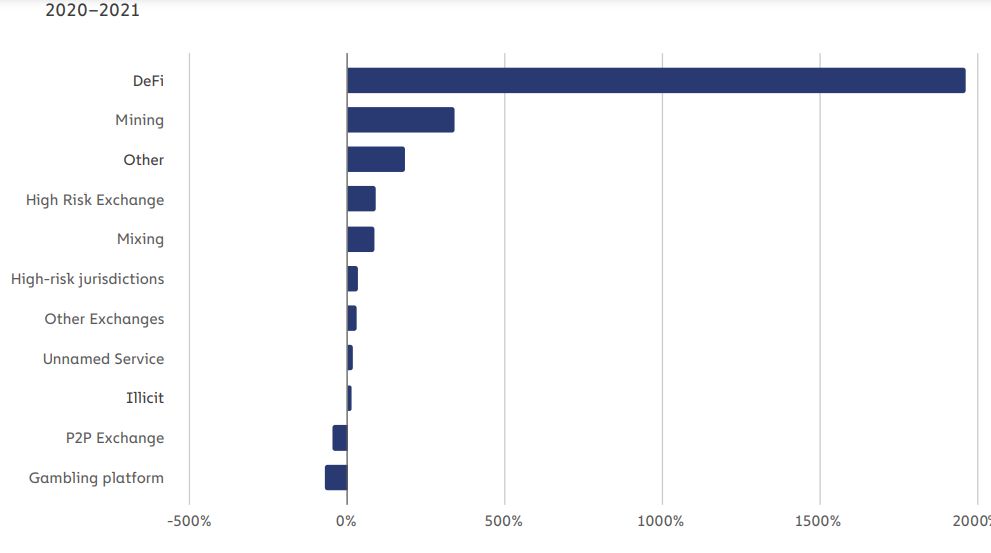
DeFi protocols saw the most growth by far in usage for
money laundering at 1,964%.
Illicit
cryptocurrency balances are growing. What can law enforcement do? One promising
development in the fight against cryptocurrency-related crime is the growing
ability of law enforcement to seize illicitly obtained cryptocurrency. In
November 2021, for instance, the IRS Criminal Investigations announced that it
had taken over $ 3.5 billion worth of cryptocurrency in 2021 — all from non-tax
investigations — representing 93% of all funds taken by the division during
that period. We’ve also seen several examples of successful seizures by other
agencies, including $56 million seized by the Department of Justice in a
cryptocurrency scam investigation, $2.3 million seized from the ransomware
group behind the Colonial Pipeline attack, and an undisclosed amount seized by
Israel’s National Bureau for Counter Terror Financing in a case related to
terrorism financing.
Does this raise an
interesting question: How much cryptocurrency are criminals currently holding?
It’s impossible to know for sure, but we can estimate based on the current
holdings of addresses Chainalysis has identified as
associated with illicit activity. As of early 2022, illicit addresses hold at
least $10 billion worth of cryptocurrency, with the vast majority of this held
by wallets associated with cryptocurrency theft. Addresses associated with darknet
markets and scams contribute significantly to this figure. As we’ll explore
later in this report, much of this value comes not from the initial amount
derived from criminal activity but from subsequent price increases of the
crypto assets held.
We believe it’s
important for law enforcement agencies to understand these estimates as they
build out their blockchain-based investigative capabilities, and especially as
they develop their ability to seize illicit cryptocurrency.n
Let’s make cryptocurrency safer
DeFi-related crime
and criminal cryptocurrency balances are just one area of focus for this
report. We’ll also look at the latest data and trends on other forms of
cryptocurrency based crime, including:
• The ongoing threat of ransomware
• Cryptocurrency-based money laundering
• Nation state actors’ role in cryptocurrency-based
crime
• Illicit activity in NFTs
And much more!
As cryptocurrency
grows, the public and private sectors must work together to ensure that users
can transact safely and that criminals can’t abuse these new assets. We hope
this report can contribute to that goal and equip law enforcement, regulators,
and compliance professionals with the knowledge to prevent, mitigate, and
investigate cryptocurrency-based crime more effectively.
DeFi Takes on Bigger
Role in Money Laundering But Small Group of Centralized Services Still Dominate
Cybercriminals
dealing in cryptocurrency share one common goal: Move their ill-gotten funds to
a service where they can be kept safe from the authorities and eventually
converted to cash. That’s why money laundering underpins all other forms of
cryptocurrency-based crime. If there’s no way to access the funds, there’s no
incentive to commit crimes involving cryptocurrency in the first place.
Money laundering
activity in cryptocurrency is also heavily concentrated. While billions of dollars worth of cryptocurrency moves from illicit
addresses every year, most of it ends up at a surprisingly small group of
services, many of which appear purpose-built for money laundering based on
their transaction histories. Law enforcement can strike a huge blow against
cryptocurrency-based crime and significantly hamper criminals’ ability to
access their digital assets by disrupting these services. We saw an example of
this last year, when the U.S. Treasury Department’s Office of Foreign Assets
Control (OFAC) sanctioned
two of the
worst-offending money laundering services — Suex and Chatex — for accepting funds from ransomware operators,
scammers, and other cybercriminals. But as we’ll explore below, many other
money laundering services remain active.
2021 cryptocurrency
money laundering activity summarized Overall, going by the amount of
cryptocurrency sent from illicit addresses to addresses hosted by services,
cybercriminals laundered $8.6 billion worth of cryptocurrency in 2021.
Total cryptocurrency value laundered by year |
2017–2021
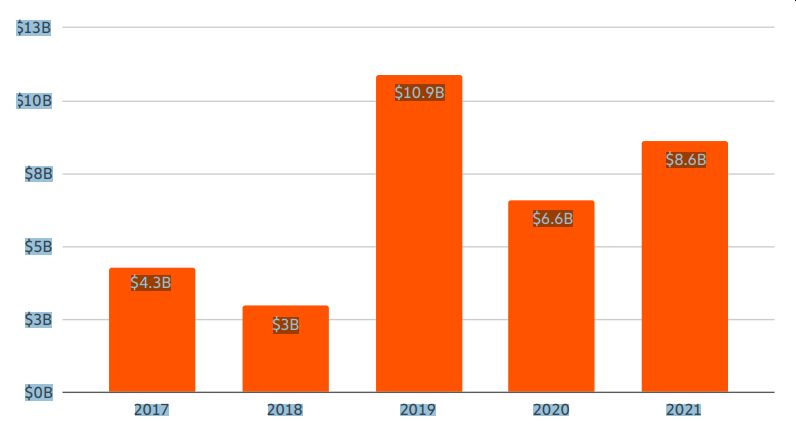
That represents a 30%
increase in money laundering activity over 2020, though such an increase is
unsurprising given the significant growth of both legitimate and illicit
cryptocurrency activity in 2021. We also need to note that these numbers only
account for\ funds derived from “cryptocurrency-native” crime, meaning
cybercriminal activity such as darknet market sales or ransomware attacks in
which profits are virtually always derived in cryptocurrency rather than fiat
currency. It’s more challenging to measure how much fiat currency derived from
offline crime — traditional drug trafficking, for example — is converted into
cryptocurrency to be laundered. However, we know this is happening anecdotally,
and later in this section, we provide a case study showing an example of it.
Cybercriminals have laundered over $33 billion worth of cryptocurrency since
2017, with most of the time moving to centralized exchanges. For comparison,
the UN Office of
Drugs and Crime estimates that between $800 billion and $2 trillion of fiat
currency is laundered each year — as much as 5% of global GDP. For comparison,
money laundering accounted for just 0.05% of all cryptocurrency transaction
volume in 2021. We cite those numbers not to try and minimize cryptocurrency’s
crime-related issues but rather to point out that money laundering is a plague
on virtually all forms of economic value transfer, and to help law enforcement
and compliance professionals be barware of just how much money laundering
activity could theoretically move to cryptocurrency as adoption of the
technology increases. The most significant difference between fiat and
cryptocurrency-based money laundering is that, due to the inherent transparency
of blockchains, we can more easily trace how criminals move cryptocurrency
between wallets and services in their efforts to convert their funds into cash.
What kinds of cryptocurrency services do criminals rely on for this?
Destination of funds leaving illicit addresses |
2016–2021
For the first time
since 2018, centralized exchanges didn’t receive the majority of funds sent by
illicit addresses last year, instead taking in just 47%. Where did
cybercriminals
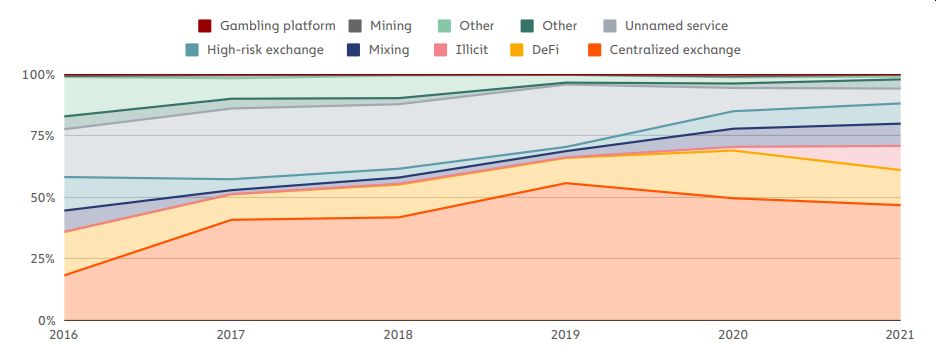
For the first time since
2018, centralized exchanges didn’t receive the majority of funds sent by
illicit addresses last year, instead taking in just 47%. Where did
cybercriminals send funds instead? DeFi protocols make up much of the
difference. DeFi protocols received 17% of all funds sent from illicit wallets
in 2021, up from 2% the previous year. That translates to a 1,964%
year-over-year increase in total value received by DeFi protocols from criminal
addresses, reaching $900 million in 2021. Mining pools, high-risk exchanges,
and mixers also saw substantial increases in value received from illicit
addresses. We also see patterns in which types of services different
cybercriminals use to launder cryptocurrency. DeFi Mining High-risk exchange
Mixing Centralized exchange Unnamed services Illicit P2P exchange Gambling
platform -500% 0% 500% 1000% 1500% 2000% Year over year percentage growth in
value received from illicit addresses by service category 2020–2021 Year over
year percentage growth in value received from illegal addresses by service
category | 2020–2021.
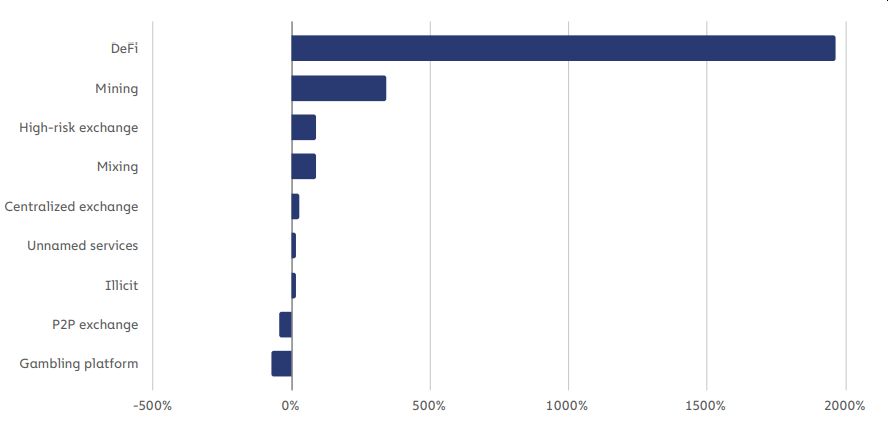
That translates to a
1,964% year-over-year increase in value received by DeFinprotocols
from illicit addresses, reaching a total of $900 million in 2021. Mining pools,
high-risk exchanges, and mixers also saw substantial increases in value
received from illicit addresses.
We also see patterns
in which types of services cybercriminals use tonlaunder
cryptocurrency.
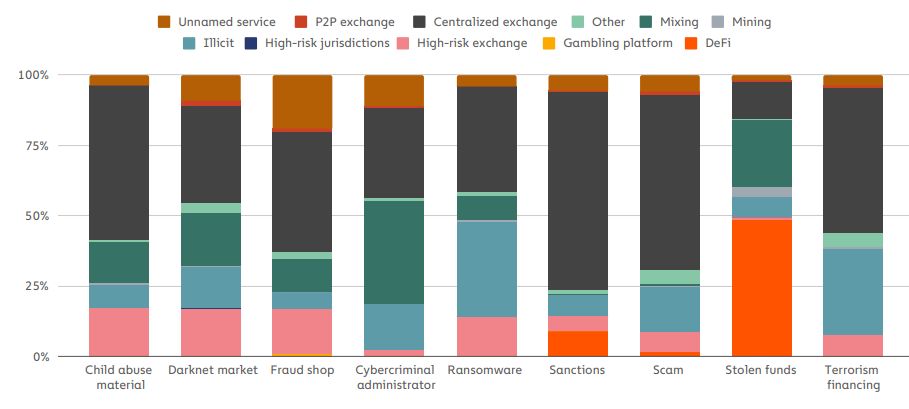
One thing that stands
out is the difference in laundering strategies between the two highest-grossing
forms of cryptocurrency-based crime in 2021: Theft and scamming. addresses associated
with theft sent just under half of their stolen funds to DeFinplatforms
— over $750 million worth of cryptocurrency. North Korea-affiliated hackers,
responsible for $400 million cost of cryptocurrency hacks last year, used DeFi
protocols for money laundering quite a bit. This may be related to more
cryptocurrency being stolen from DeFi protocols than any other platform
previous year. We also see an actual mixer usage in the laundering of stolen
funds.
On the other hand,
scammers send most of their funds to addresses at centralized exchanges. This
may reflect scammers’ relative lack of sophistication. Hacking cryptocurrency
platforms to steal funds takes more technical expertise than carrying out most scams
we observe, so it makes sense that those cybercriminals would employ a more
advanced money laundering strategy.
We also need to
reiterate that we can’t track all money laundering activity by measuring the
value sent from known criminal addresses. As stated above, some criminals use
cryptocurrency to launder funds from offline crimes, and many illegal addresses
in use have yet to be identified. However, we can account for some of these
more obscured instances of money laundering by looking for transaction patterns
suggesting that users were trying to avoid compliance screens. For example, due
to regulations like the Travel Rule, cryptocurrency businesses in many
countries must conduct additional compliance checks, reporting, and information
sharing related to transactions above USD 1,000. As you might expect, illicit
addresses send disproportionate transfers to exchanges just below that $1,000
threshold. Number of transfers from criminal addresses to exchanges by transfer
size | 2021 Transfer size range
Number of transfers from illicit addresses to
exchanges by transfer size | 2021

Part Two, Part Three, Part Four, Part Five
For updates click hompage here